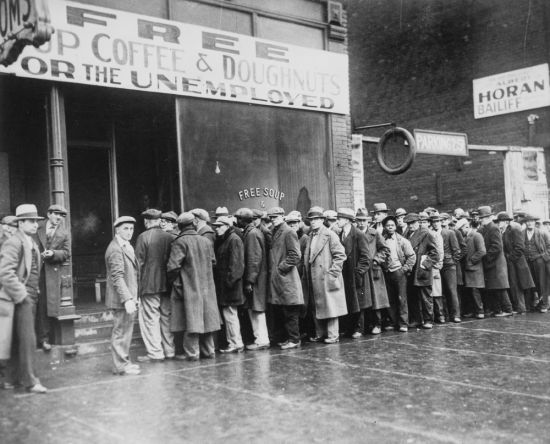The Memory of Great Depression
回忆大萧条
The Great Depression was a severe worldwide economic depression in the decade preceding World War II. The timing of the Great Depression varied across nations, but in most countries it started in about 1929 and lasted until the late 1930s or early 1940s. It was the longest, most widespread, and deepest depression of the 20th century, and is used in the 21st century as an example of how far the world’s economy can decline. The depression originated in the United States, triggered by the stock market crash of October 29, 1929 (known as Black Tuesday), but quickly spread to almost every country in the world.
大萧条是一场发生在二战前10年严重的全球性经济萧条。大萧条发生的时间在各国各不相同,但是在大多数国家都是从1929年开始持续到30年代末期或是40年代初期。这是20世纪持续时间最长、波及范围最广、影响最大的一次严重萧条,而且这次萧条也被21世纪的人们拿来当做经济衰退的例子,告诉人们经济可以衰退到什么程度。这场大萧条始于美国,由1929年10月29日(也就是人们常说的黑色星期二)股市崩盘引发,然后迅速蔓延至全球许多国家。
The Great Depression had devastating effects in virtually every country, rich and poor. Personal income, tax revenue, profits and prices dropped, and international trade plunged by half to two-thirds. Unemployment in the United States rose to 25%, and in some countries rose as high as 33%. Cities all around the world were hit hard, especially those dependent on heavy industry. Construction was virtually halted in many countries. Farming and rural areas suffered as crop prices fell by approximately 60 percent. Facing plummeting demand with few alternate sources of jobs, areas dependent on primary sector industries such as cash cropping, mining and logging suffered the most.
这次大萧条几乎对每个国家都产生了毁灭性的影响,不管是富国还是穷国。个人收入、税收、盈利和价格下降、国际贸易业减少了一半甚至三分之二。美国的失业率上升至25%,而在其他一些国家失业率甚至高达33%。全球许多城市都遭受到了重创,特别是那些依赖于重工业的地区。很多国家的建设都几乎暂停。农业和郊区都遭遇了农产品价格下降近6成的损失。面对直线下降的需求和无法供应足够的可替代工作岗位,第一产业部门遭受到的损失最为严重,例如经济作物种植业、煤矿业和伐木业。

Historians most often attribute the start of the Great Depression to the sudden and total collapse of the US stock market on October 29th, 1929, known as Black Tuesday. However, some dispute this conclusion, and see the stock crash as a symptom,rather than a cause of the Great Depression. Even after the Wall Street Crash of 1929, optimism persisted for some time; John D. Rockefeller said that "These are days when many are discouraged. In the 93 years of my life, depressions have come and gone. Prosperity has always returned and will again." The stock market turned upward in early 1930, returning to early 1929 levels by April, though still almost 30% below the peak of September 1929. Together, government and business actually spent more in the first half of 1930 than in the corresponding period of the previous year. But consumers, many of whom had suffered severe losses in the stock market the previous year, cut back their expenditures by ten percent, and a severe drought ravaged the agricultural heartland of the USA beginning in the summer of 1930.
历史学家经常把1929年10月29日(黑色星期二)美国股市的突然和全面崩盘作为此次大萧条的开端。然而,对此结论有人看法不同,他们认为股市崩盘只是一个现象而不是造成大萧条的原因。即使在1929年华尔街股市崩盘之后,乐观主义者仍旧坚持了一段时间;约翰·洛克菲勒就说:“过在那段时间里,很多人都失去了信心。在我生命的93年里,萧条总是来了又走。繁荣总是会再次回来。”股市在30年代早期开始回暖,在4月回升到1929年以前的水平,尽管比1929年9月最高峰时期仍低了近30%。政府和商业在30年代前五年的加起来的花费比大萧条之前的几年的花费更多。但是消费者其中很多在前些年的股市崩盘中遭受了严重的损失,他们不得不减少了近一成的开支费用,并且1930年夏天开始,一场严重的旱灾袭击了美国农业的核心地带。
By mid-1930,interest rates had dropped to low levels, but expected deflation and the reluctance of people to add new debt by borrowing, meant that consumer spending and investment were depressed. In May 1930, automobile sales had declined to below the levels of 1928. Prices in general began to decline, but wages held steady in 1930; but then a deflationary spiral started in 1931. Conditions were worse in farming areas, where commodity prices plunged, and in mining and logging areas, where unemployment was high and there were few other jobs. The decline in the US economy was the factor that pulled down most other countries at first, then internal weaknesses or strengths in each country made conditions worse or better. Frantic attempts to shore up the economies of individual nations through protectionist policies, such as the 1930 US Smoot-Hawley Tariff Act and retaliatory tariffs in other countries, exacerbated the collapse in global trade. By late in 1930, a steady decline set in which reached bottom by March 1933.
到30年代中期,利率开始下降到较低水平,但是预期的通货紧缩和人们不想通过借债增加新债的心理,意味着消费和投资将会下降。1930年5月,汽车销量下降到比1928年更低的水平。1930年物价普遍下降,但是工资却保持平稳;从1931年开始通货紧缩程度开始螺旋式上升。农业地区的情况更为糟糕,他们的商品价格下降,而在煤矿和伐木领域,失业率非常高且几乎没有其他工作可做。一开始,美国经济的衰退是导致其他国家经济萧条的重要原因之一,接着各国各自的优劣势使得情况或好或坏。急切地想要发展经济的想法使得很多国家实施保护主义政策,比如1930年的美国斯穆特一霍利关税协议和其他国家报复性的关税设定,加速了全球贸易的崩溃。到1930年末期,一场持续衰退一直到1933年的3月达到了谷底。













